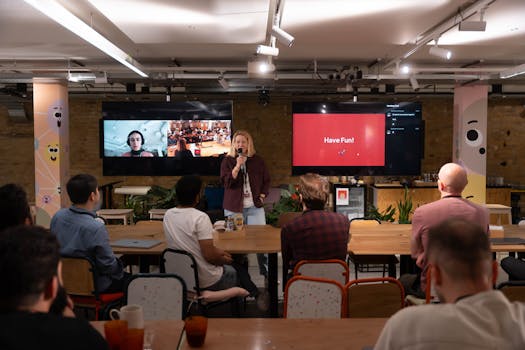Career
Unlocking Creativity: Transforming Traditional Professions for Success
Discover how creativity can transform traditional professions like accounting and law. Explore strategies to promote innovation and job satisfaction.
Advertisement
Creativity is often viewed as an innate trait reserved for artists, musicians, or innovative techies. However, traditional professions like accounting, law, and education can benefit immensely from creative thinking. Fostering creativity in these fields can lead to enhanced problem-solving, increased adaptability, and improved job satisfaction.
Many professionals in traditional fields may feel constrained by established norms and processes. Yet, introducing creative strategies can not only invigorate these roles but also lead to innovative solutions that significantly improve day-to-day operations. Creativity encourages fresh perspectives, which can redefine how challenges are approached.
This article explores various strategies to cultivate creativity in traditional professions, offering actionable insights tailored for individuals and organizations. Discover how fostering an environment of creativity can inspire professionals to break free from monotony and thrive in their careers.
Understanding Creativity in Traditional Professions
Creativity is not exclusive to artistic endeavors; it plays a crucial role in various traditional professions. Recognizing its value in fields like education, law, and accounting is essential to inspire change.
Incorporating creativity into these professions can lead to innovative approaches to problem-solving. For instance, teachers can use creative methods to engage students, while accountants can develop novel ways to analyze financial data.
Furthermore, legal professionals can devise innovative strategies for case management or client interactions. Understanding how creativity applies to one’s profession is the first step toward embracing its benefits.
By acknowledging the intersection of creativity and traditional roles, professionals can initiate changes to enhance their work experience. This mindset shift lays the foundation for implementing creative strategies.
Ultimately, fostering creativity within traditional professions contributes to a more dynamic workplace and encourages sustained professional growth. Embracing this change is necessary for long-term success.
Encouraging a Collaborative Work Environment
Collaboration fosters creativity by combining diverse perspectives and ideas. By encouraging teamwork, professionals can spark innovative solutions to complex problems.
Regular brainstorming sessions can help break down silos and cultivate a sense of community. Team-building activities also strengthen relationships, allowing for more open communication among colleagues.
Utilizing collaborative tools, such as shared digital platforms, can promote idea-sharing and streamline workflows. This encourages individuals to express their thoughts without fear of judgment.
Moreover, creating spaces specifically designed for collaboration can enhance creative efforts. Comfortable, well-equipped meeting areas invite open dialogue and idea generation among teams.
By valuing collaboration, organizations can set a solid foundation for cultivating creativity across traditional professions, ultimately improving performance and satisfaction.
Implementing Ongoing Learning and Development
Emphasizing continuous education helps professionals stay updated on industry trends while nurturing their ingenuity. Providing access to workshops, seminars, and courses can enhance skills and inspire creative thinking.
Encouraging employees to attend conferences exposes them to new ideas and innovative practices. Networking opportunities can reveal insights from professionals in different sectors.
Moreover, fostering a culture of learning encourages employees to think critically. Encouraging experimentation and flexibility in applying new ideas promotes a creative atmosphere.
Mentorship programs also play a vital role in sharing knowledge, offering insights, and supporting creative growth. By guiding younger professionals, mentors inspire and nurture upcoming talent.
In an environment where learning is prioritized, creativity thrives, leading to increased motivation and job satisfaction among employees.
Encouraging Risk-Taking and Experimentation
Creating a safe space for risk-taking is crucial to sparking creativity in traditional professions. Allowing employees to experiment without fear of failure fosters an innovative mindset.
Encouraging employees to try new methods, even if they lead to setbacks, promotes resilience. Understanding that failure is a part of growth can change perspectives toward creative endeavors.
Organizations can implement a framework that rewards innovation and creative risks. Recognizing and celebrating successful experiments reinforces the value of creative contributions.
Moreover, creating a feedback-rich culture enables individuals to refine their ideas. Constructive feedback fosters improvement and enhances creative outputs.
By embracing risk-taking, traditional professions can unlock their creative potential, leading to groundbreaking solutions and advancements.
Utilizing Technology to Enhance Creativity
The rapidly evolving technological landscape provides numerous tools to foster creativity. Leveraging technology can help professionals streamline tasks, visualize ideas, and implement creative solutions.
Collaborative software allows teams to brainstorm ideas and manage projects efficiently. Virtual platforms can enable remote collaboration, breaking geographical barriers and encouraging diverse input.
Utilizing design thinking methodologies can also guide professionals through structured approaches to creativity. Online resources can provide templates and frameworks to inspire creative problem-solving.
Additionally, technology can help automate mundane tasks, freeing up mental space for innovative thinking. By reducing time spent on repetitive work, employees can focus on more complex challenges.
Encouraging professionals to explore and adopt technology ultimately enhances creativity across traditional professions, leading to increased efficiency and innovation.
Fostering a Culture of Open Communication
Open communication is essential for nurturing creativity in traditional professions. Encouraging employees to voice ideas and concerns fosters an atmosphere of trust and collaboration.
Regular check-ins and feedback sessions can facilitate open dialogue, enabling employees to share thoughts without hesitation. This transparency nurtures creativity and innovation.
Additionally, maintaining open channels for communication can enhance team dynamics. Understanding diverse perspectives allows professionals to approach challenges more creatively.
Encouraging leaders to be approachable fosters an environment where every employee feels empowered to contribute. This inclusivity promotes creativity and drives collective growth.
In fostering open communication, organizations create a culture that values creativity and encourages continuous improvement across traditional professions.
Conclusion: The Path to Creative Transformation
Fostering creativity in traditional professions is a powerful strategy for enhancing job satisfaction and encouraging innovative solutions. By implementing collaborative environments, embracing ongoing learning, promoting risk-taking, leveraging technology, and ensuring open communication, organizations can cultivate creativity effectively.
As creativity becomes an integral part of professional life, traditional roles evolve into more dynamic positions. Such transformation positively influences both individuals and organizations, creating a ripple effect of innovation.
By encouraging creativity, we can redefine conventional practices, making traditional professions more adaptable and fulfilling. Ultimately, it leads to a brighter and more innovative future for all sectors.





